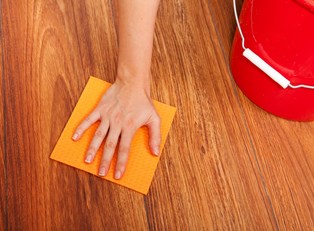One way to spruce up your home is to add a new floor. This will give your home a fresh clean look and possibly add value to your home. But which flooring is the best fit for your family? Here is some information to get you started with your flooring research.
Do you want something easy to install?
Laminate flooring is similar in many ways to engineered wood: Both are floating floors made up of tongue-and-groove planks that snap together. And both floors come in various widths, and dozens of colors and wood-grain patterns. The primary difference between the two is that the top surface of laminate flooring is made of plastic laminate, not hardwood. Also, laminate flooring comes in slightly shorter planks, usually about 47 inches long. The big advantage laminate flooring has over any real-wood floor is that it's extremely resistant to stains, scratches, fading, damage, and wear. It snaps together simply and can be installed by one or two people over a weekend.
Can you handle a difficult to install floor?
Solid hardwood flooring is the most difficult of all to install. It’s usually attached with a special flooring nail then sanded with a drum-type floor sander and finished. The sanding process can be tricky if you haven’t done it before, and since the smoothness of the sanding can make or break the look of a wood floor, you might want to consider hiring that part out even if you decide to lay and finish the floor yourself.
Do you need something more affordable?
Resilient vinyl sheeting used to be fastened down with not-so-easy-to-apply mastic. These days, installation of this kitchen-and-bath-friendly flooring is considerably easier. You simply remove the shoe molding from around the room, make a paper template of the room, cut the flooring to size using a utility knife, lay the flooring down and replace the molding. There’s no glue, no staples, no nails.
Sheet vinyl flooring typically comes in 12-foot-wide rolls, resulting in seamless coverage in most rooms. Prices start at about $2 per square foot. One foot-square peel-and-stick vinyl tiles, which start at about $1 per square foot, are also available for even easier do-it-yourself installation.
Ceramic tile flooring is not the absolute cheapest flooring option, nor is it the easiest to install, but its durability and long lifespan make it worth considering. The success of any tile job depends on a solid base with little flex in it. If the old floor is sturdy and even, you can simplify the tiling job by covering the old floor with a thin underlayment that gives you a fresh, clean start. You’ll likely need to rent or borrow a wet saw for the project. If you’re comfortable using basic hand tools and have the patience to align tiles just right, you can handle this job. Ceramic tile, uninstalled, costs anywhere from $3 to upward of $50 per square foot.
Can you afford to splurge?
Granite, marble, quartz, and radiant heated floors are some of the most expensive types of flooring to install. Each needs to be installed by a professional installer and requires very specific equipment and knowledge to install correctly. If you have the money, they are all beautiful flooring options that add significant value to your home.



